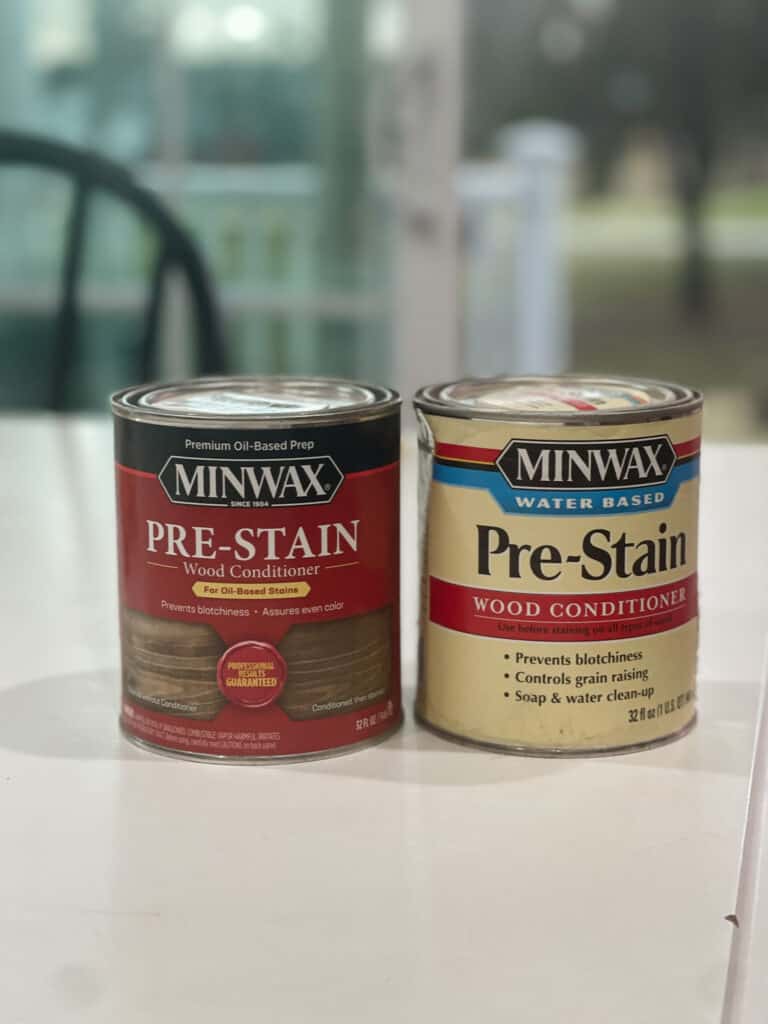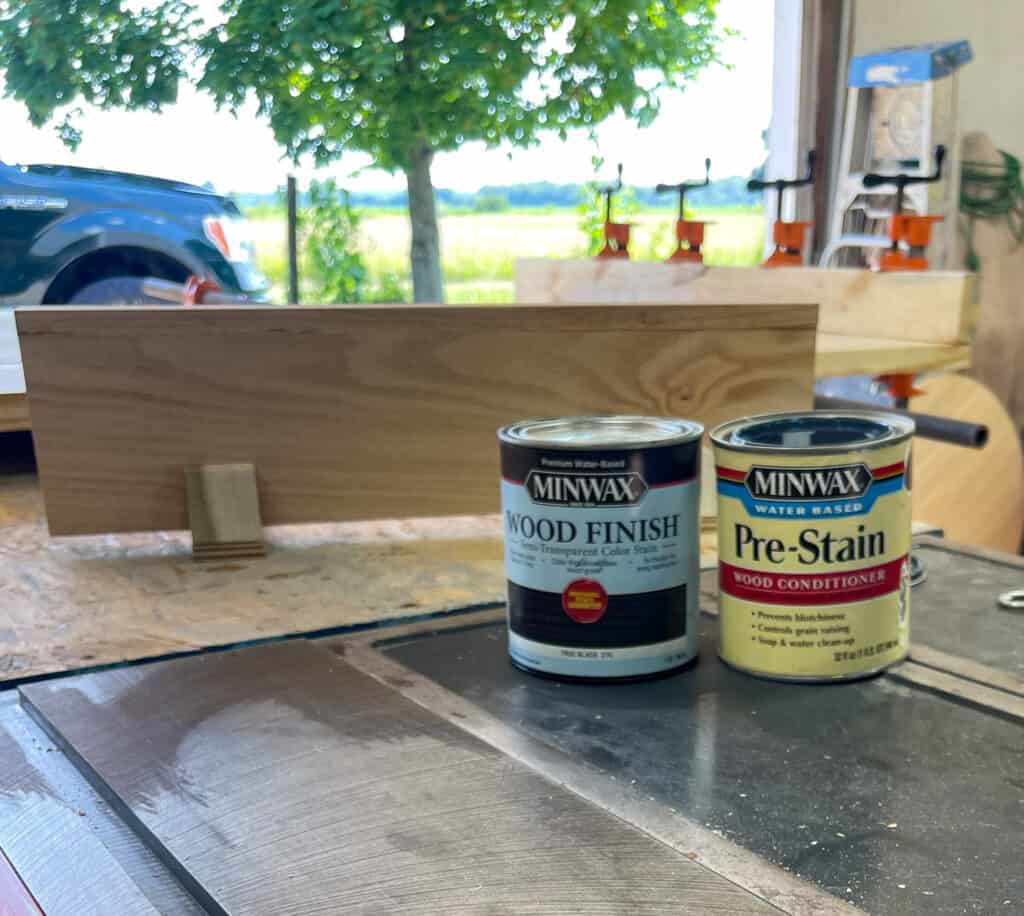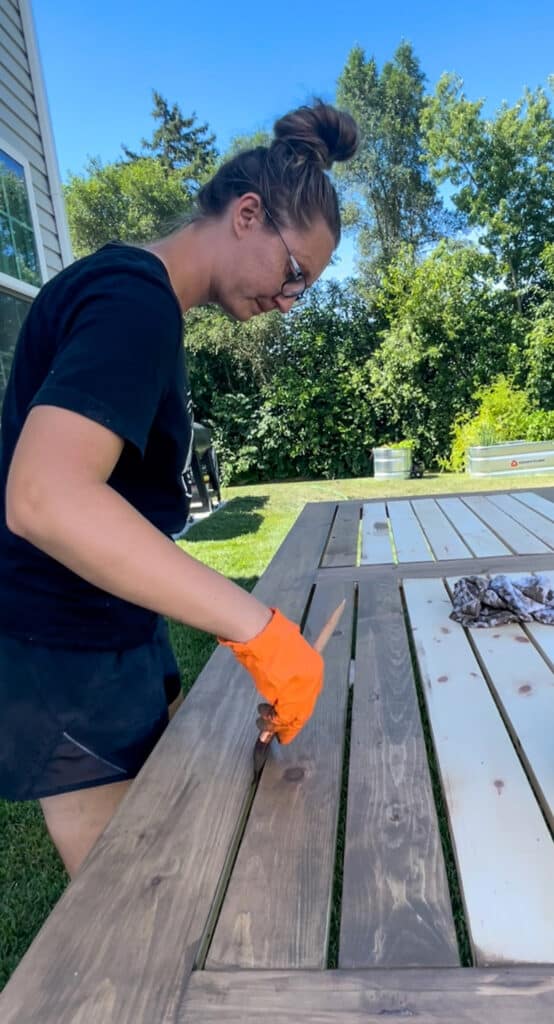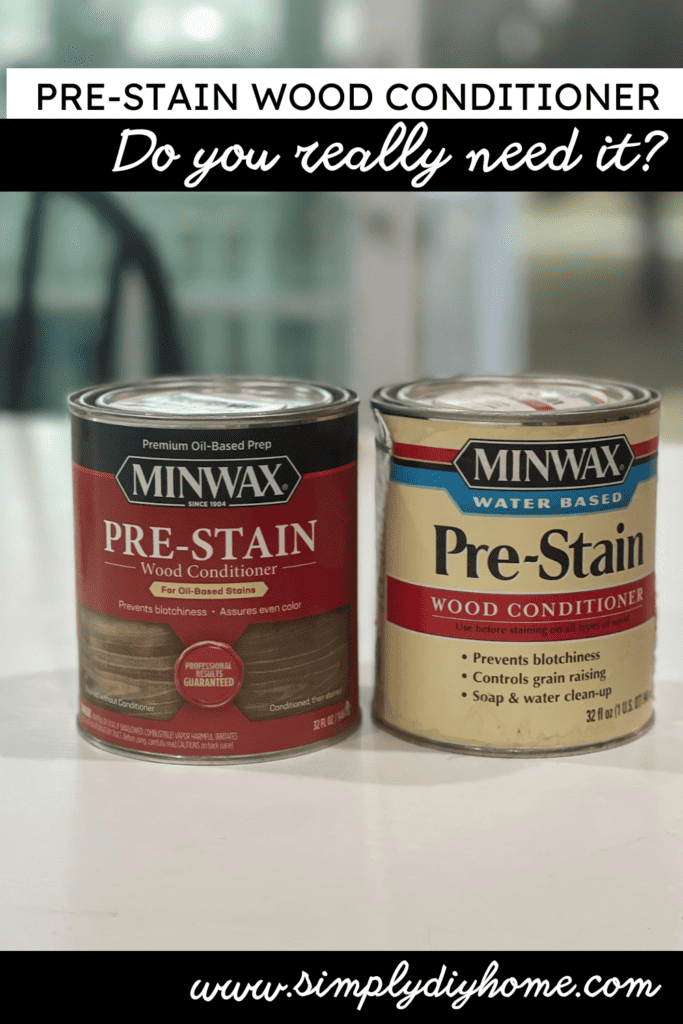In this article, you will discover the ins and outs of pre-stain wood conditioner and learn if it’s crucial for your woodworking projects.

Ever faced frustration with your staining project ending up uneven or blotchy? This often happens without the magic touch of pre-stain wood conditioner. Dive into the full guide of tips and tricks, and discover how this essential step can become your project’s best ally for perfect finishes every time!
Let’s get started!
[AFFILIATE LINKS ARE PROVIDED BELOW FOR CONVENIENCE. FOR MORE INFORMATION SEE MY DISCLOSURE HERE.]
What Is Wood Conditioner?
A pre-stain wood conditioner is a product you apply to wood surfaces before staining. Wood, by nature, has varying degrees of porosity across its surface, which can lead to uneven absorption of stain and an irregular finish.
The wood conditioner’s primary role is to ensure that the stain is absorbed evenly, preventing the common problem of blotchiness and ensuring a smooth, uniform finish. This is particularly important for soft or porous woods like pine or fir, which have a tendency to absorb stain unevenly due to their softness.
What Does Pre-Stain Conditioner Do?
Wood conditioner acts as a primer! It’s job is to fill in all those uneven spaces on your piece of wood to create a fresh new even surface. Then you can come in with a stain of your choice and get a flawless finish!
Custom Stain Combo
Want to know my custom stain combo I use on about everything? Check out How To Stain Wood: My Special Stain Combo.
Different Types Of Wood Conditioner?
When going to your local hardware store like Lowe’s or Home Depot you have two choices for wood conditioner. There is a water based and a oil based conditioner. You want to make sure you choose the correct one because water and oil don’t mix.
For example if your stain is oil based you want to make sure your wood conditioner is also oil based!
Water-Based Wood Conditioner
Water-based pre-stain is compatible with water-based stains. These conditioners dry more quickly and have less odor, making them suitable for indoor projects. They are a fan favorite due to them being easier to clean up, requiring only soap and water.

Oil-Based Wood Conditioner
Oil-based pre-stain is compatible with oil-based stains. The oil-based conditioners deeply penetrate wood which result in longer drying time. But, this also will require a well-ventilated area due to stronger odors.
The only way to clean up oil-based is to use mineral spirits. This is why I typically use rags when staining so I can skip cleaning any brushes when using oil-based products.
Properly laying out rags after staining is crucial for safety! Stain-soaked rags can be a fire hazard due to the potential for spontaneous combustion. Spreading them out allows the solvents to evaporate safely, reducing this risk.
Which Wood Species Require Pre-Stain Conditioner?
When it comes to wood projects, certain species often require a pre-stain conditioner to ensure an even finish. The following wood species are the most common:
- Pine (I use this for most of my projects)
- Birch
- Fir
- Cherry
Most of these wood species are softwoods, which are known for their uneven grain patterns and porosity. More expensive woods like oak don’t require a pre-stain conditioner because of its tight and uniform grain structure!

How Do You Apply Wood Conditioner?
Applying a pre-stain involves a few simple steps.
When applying wood conditioner, start by making sure your wood surface is clean and smooth. Apply the pre-stain with a brush or cloth, following the wood grain. I almost always use a cloth, unless I’m trying to get in small grooves then I’ll use a brush.
Allow it to penetrate the wood for about 3-5 minutes, then wipe off any excess. Now you are ready to apply your stain! Some people wait for a certain amount of time before jumping into staining but I have every time just went straight into staining and never had a problem.
If you aren’t staining your piece right after just make sure it’s within 2 hours so your pre-stain doesn’t dry completely.
Common Mistakes to Avoid When Using Pre-Stain
Here is a list of common mistakes that could be made when using pre-stain:
- Skipping Sanding: Not sanding the wood properly before applying the conditioner can lead to an uneven finish. Take your time and make sure you sand the whole board.
- Inconsistent Application: Applying the conditioner unevenly can result in blotchy areas after staining.
- Over-Conditioning: Applying too much conditioner can seal the wood too much, preventing the stain from penetrating effectively. I have done this before and had to go back and add more stain to get a darker finish.
- Wrong Conditioner Type: Using a water-based conditioner with an oil-based stain or vice versa can lead to compatibility issues.
Frequently Asked Questions
While skipping the pre-stain conditioner is possible, it’s not recommended for softwoods due to their uneven stain absorption. However, for harder woods with tighter grains, such as oak , you might achieve better results without a conditioner.
If you choose to not use it on your softer woods you run into the problem of uneven stain application.
It is possible that pre-stain wood conditioner can slightly lighten the final color of the stain by reducing the amount of stain the wood absorbs.
Pre-stain wood conditioner is best used on bare, untreated wood. Applying it over existing stains or paints won’t have the desired effect and is not recommended.
For the best results, I suggest sanding the wood back to its natural state before conditioning and staining.
Yes, it’s possible to make a DIY pre-stain using natural or household ingredients, such as a mixture of linseed oil and mineral spirits. However, the effectiveness of homemade conditioners may vary, and they might not provide the same results as commercial products.
I have never tried this but I have seen videos on youtube of others experimenting with the idea!
Now you are a pro at all things wood conditioner! I hope this info was helpful and you learned a thing or two. Happy Staining!

[Safety is of great importance when working on DIY projects. Always follow proper safety guidelines, wear appropriate personal protective equipment, and adhere to local building codes and regulations. READ MY FULL DISCLAIMER HERE.]

